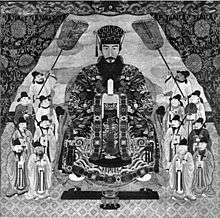Ogoe
Ogoe (御後絵, Okinawan: うぐい) are posthumous Okinawan portraits. Although it is unknown when the tradition of portraiture first began in the area, Ryukyu developed a unique style during the 15th-19th centuries.

In the past the portraits were painted directly onto the walls of the Enkaku-ji Buddhist Temple in Okinanawa as murals but it is believed that owing to damage caused by fires to the temple, in 1717 the court artist to the Ryukyu Kingdom, Soki Yamaguchi, converted all the portraits to wall hung scrolls or kakejiku.[1]
Ten are confirmed to have existed through monochrome photos taken by Kamakura Yoshitarō; all known ogoe were destroyed during the 1945 Battle of Okinawa.[2][3]
Ogoe were all painted in similar style; they all place the king in the center surrounded by high officials and other retainers, with the king much larger than the others to emphasize his power and authority.[4]
References
- "Shurijo Castle Park Exhibition. King's Portraits (Ogoe)" (PDF). oki-park.jp. Retrieved 2018-12-06.
- "国王の威厳 色鮮やかに 尚灝王の「御後絵」復元" [The majesty of the King colorfully brought back to life from the lord's "after-life picture"]. ryukyushimpo.jp (in Japanese). Retrieved 2018-12-06.
- "Shurijo Castle and Kume Village Exhibition/Okinawa Island Guide". www.oki-islandguide.com. Retrieved 2018-12-06.
- "御後絵 (おごえ)" [After-life painting (Ogie)]. ryukyushimpo.jp (in Japanese). Retrieved 2018-12-06.